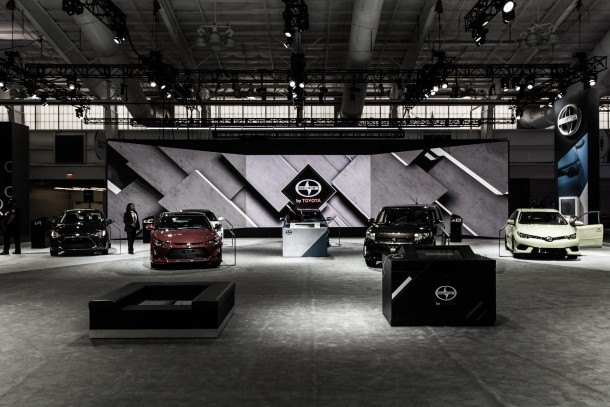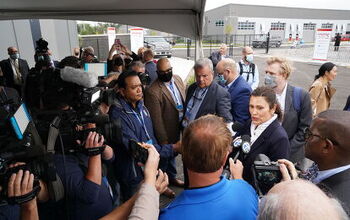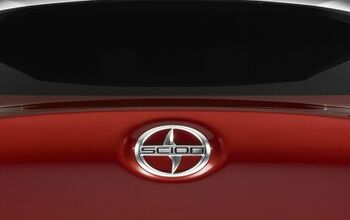A Funeral at an Auto Show

Prior to the New York International Auto Show, Toyota distributed an upbeat press release. Come party with us, it said. “Scion is not going away quietly.”
Yet, as I walk toward Scion’s booth, a quiet unease fills a void once occupied by a loud, confident generational pulse. The typical eye-catching signs with heavily embossed, trendy hashtags are all but entirely absent upon my arrival. Massive subwoofers sit dormant inside 13 years’ worth of one-off tuner concepts. Engineered studio lighting softly highlights the vehicles on display, while simultaneously attempting to hide the vast, empty spaces between them.
Scion’s show booths are normally chock-full of tchotchkes and the beautiful people handing them out — but not today.
You see, Scion’s booth is located far away from the main action of the week. In many ways, Jacob Javits Center’s North Hall is the auto show version of New York’s Hart Island.
Shortly after the Civil War, Hart Island became the dumping ground of New York City’s unclaimed dead. The mass grave operates primarily as a potter’s field. North Hall, free of the constant hum of activity that electrifies the main auto show floor, is the surreal orphanage of brands oft-forgotten: Mitsubishi, Mini and (surprisingly) Subaru, in addition to Scion. And it’s in this hall that the Japanese giant’s uncommon resignation manifests itself. Scion sits cast out, chagrined, and surrounded by signs that read “Scion by Toyota” as if forced to completely give up its own identity.
Against an eerie backdrop of absolute silence, the booth operates entirely unstaffed. A security guard stands subdued in the far corner of the booth, swinging one of her legs to and fro as if to boringly kick an invisible soccer ball over and over. Near her, an auto show custodian kills time between vehicle dustings to aimlessly poke at one of the booth’s marketing installations.
Six concepts that helped define Scion’s raison d’être at various points in its brief history populate one end of booth. Among them is the near-perfect Scion BBx Concept that launched the brand in 2002 to near ravenous intrigue. It evolved soon after into the production Scion xB — a rebadged Japanese import loved by a generation that craved style and practicality in an affordable package. In contrast, the horrendous Slayer tC show car is evidence that Scion completely lost its way by 2014. It’s this sliding scale of concepts that portended the brand’s current reality of dissolution.
Just as I was contemplating my exit, a stocky man with thinning hair appears in the booth escorted by an entourage of handlers. He’s wearing a conservative suit that’s entirely unbecoming of a Scion enthusiast. Yet, this man is none other than Jim Lentz, founding vice president of Scion and current CEO of Toyota Motor North America.
I approach Mr. Lentz with trepidation, and — surprisingly — he’s more than willing to stand with me as we admire what once was and what will no longer be.
“It’s fun when you look at all the old concepts to see how daring Scion was to push the envelope,” Lentz says with a slight smile of remembrance. “It’s sad to see it go, but — at the same time — it served its purpose.”
I continue to peruse the booth after our chat, inspecting the vehicles and displays while also trying to understand this overwhelming sense of finality. There’s something soul crushing about it all, but I can’t put my finger on it. I feel like a club patron who’s arrived two hours too early.
Then I realize something staggering: nobody else is coming.
If you don’t remember, Scion’s purpose was to cater to us: the millennials who have slowly increased our buying power to a point where all automakers now consider us a force to be reckoned with. It stuck its neck out in 2003 when others refused to budge.
In years since, our generation has slowly built up its buying power to captivate the attention of Ford, GM, and even Toyota itself, to the point where Scion’s existence was no longer a niche proposition. Now, in its death, instead of being surrounded by friends in its time of hospice, Scion’s exit is being treated with the same collective indignity as Christo’s slow and painful death in “The Beach.” Why go to a funeral when there’s a party going on next door?
My only fear is that Scion’s story will be forgotten here, in this automotive Hart Island, and nobody will care enough in decades future to visit the dead.

More by Mark Stevenson
Latest Car Reviews
Read moreLatest Product Reviews
Read moreRecent Comments
- Legacygt It was more than 20 years ago that the Bangle designed BMW sedans started looking a little bit awkward. But the lineup today is chock full of downright ugly vehicles. This is one of them.
- Jeff It does state in this article that Europeans as well as Americans have cooled on EVs. I can see push back from consumers on the 2035 deadline for EVs in Europe and in states like California. I have no problem with manufacturers offering EVs but many for at least now don't want EVs. Maybe GM instead of planning to do away with the Malibu to make more EVs should have offered the Malibu as only a hybrid like Toyota is offering the Camry for 2025. It would cost GM a lot less to offer a hybrid Malibu and it would outsell any EV that plant would produce. I even think GM would increase sales of the Malibu as a hybrid only and more competitive pricing.
- Kwik_Shift_Pro4X I fell asleep looking at that image.
- Verbal Rented a Malibu a while back. It was fine, if a bit gutless.I get that Detroit wants to go all-in on high profit margin SUVs and blinged-out MAGA trucks. Everyone has known for decades that they can't compete on price in the affordable sedan space. So now all of Detroit's sedans are gone except for a couple of Cadillac models.But you'd think that just one of the domestic brands could produce a fun, competitive and affordable sedan. Just one? Please? Anyone? Bueller?
- 3-On-The-Tree I wouldn’t even use Ford as a hearse for fear of being late to my party.




































Comments
Join the conversation
Baby Boomers were supposed to forever young and rebellious by design. GM's Saturn project was different from Scion in the sense that Saturns were unique designs including engines and not rebadges like Scions were. Saturn served its purpose but in best GM's tradition the parent company ignored its own experiment making it useless waste of money. So Saturn's death was a more depressing event event than Scion's. Olds was a real innovating company bought by GM and Pontiac was renamed Oakland Motor Car company from 30s - also the real car company bought by GM. Scion is more like Mercury.
If Scion disappears then what are the armchair automotive CEOs going to discuss?